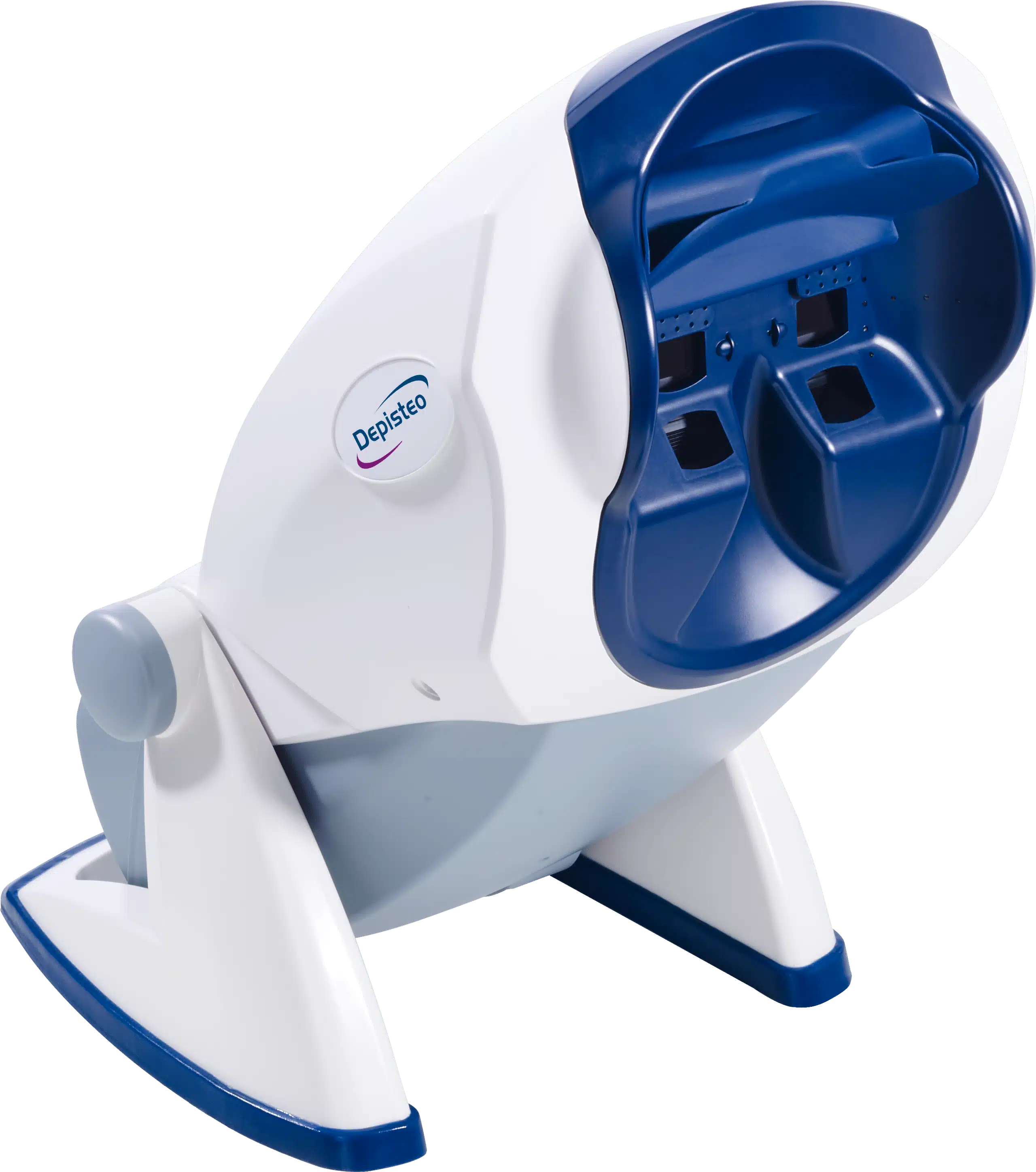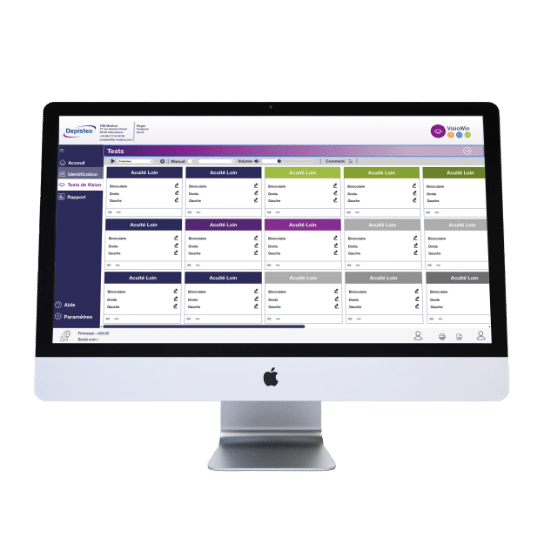VT1 4K
Vision Screeners
Screening for Visual Disorders
For children and adults in under 5 minutes, the VT1 4K Vision Tester
platform enhances workflow with its user-friendly interface
and customizable sequences.

For children and adults in under 5 minutes, the VT1 4K Vision Tester
platform enhances workflow with its user-friendly interface
and customizable sequences.
Why use VT1 vision screening device ?

Vision screening represents a critical first step in identifying potential eye problems before they progress to more serious conditions. As healthcare administrators and optometrists increasingly recognize the value of early detection, selecting the right vision screening machine becomes essential for delivering quality patient outcomes while maintaining operational efficiency.
Modern vision screening technology has evolved significantly, offering healthcare providers powerful tools to detect vision problems across diverse populations. Whether you’re screening children in schools, adults at DMV locations, or conducting general population assessments, understanding the capabilities and features of contemporary screening devices helps ensure you make informed equipment decisions.
A vision screening machine serves as an automated diagnostic tool designed to quickly identify individuals who may require comprehensive eye examinations. Unlike complete eye exams, these devices focus on detecting specific vision problems and risk factors through standardized testing protocols.
Contemporary vision screeners incorporate advanced digital technology to provide accurate measurements across multiple vision parameters. These devices can assess visual acuity, detect refractive errors including myopia, hyperopia, and astigmatism, evaluate color perception, and screen for conditions like strabismus.
The evolution of vision screening technology has introduced features like 4K displays, computerized controls, and comprehensive data management systems. These advancements enable healthcare providers to conduct thorough screenings while streamlining workflow and improving patient experience.
Modern vision screening machines utilize high-resolution displays to present clear, precise visual targets. Advanced devices feature 4K displays that offer exceptional image sharpness and customization options. This technology allows practitioners to adjust brightness, distance, and optotype parameters to accommodate different testing requirements and patient needs.
The quality of display technology directly impacts screening accuracy. Sharp, well-defined visual targets ensure that measurements reflect true visual capabilities rather than limitations of the testing equipment.
Efficient vision screeners incorporate automated testing sequences that standardize procedures while reducing human error. Random acuity tests prevent memorization during screening, ensuring that results accurately reflect visual capabilities. This feature proves especially valuable in school settings where students might be tested multiple times.
Professional medical organizations recommend early vision screening across multiple age groups, making automated protocols essential for consistent results.
Modern vision screening machines offer sophisticated data management capabilities that support electronic health record integration. These systems can store patient results, generate comprehensive reports, and facilitate easy transfer of information to healthcare providers and administrative systems.
Quick data export, one-click settings transfer, and seamless integration with business software packages enhance operational efficiency while supporting quality documentation requirements.
Benefits of a computerized version:

General population vision screening serves as a cornerstone of preventive healthcare, identifying vision problems across diverse age groups and demographic populations. Effective screening programs require equipment capable of accommodating various patient cooperation levels and specific clinical needs.
Vision screening machines designed for general population use must provide comprehensive testing capabilities while maintaining ease of operation. These devices typically offer both binocular and monocular testing modes, multiple distance settings, and adjustable luminosity options to accommodate different screening environments.
The versatility of modern screening systems allows healthcare providers to adapt their approach based on patient age, cooperation level, and specific clinical needs. This flexibility proves essential when examining patients who may have difficulty with traditional testing methods.
School vision screening programs play a vital role in identifying children with vision problems that may impact academic performance and overall development. Research indicates that less than 15% of preschool children receive comprehensive eye examinations, making school-based screening an essential component of pediatric eye health.
Children present unique screening challenges. Young patients cannot always describe their vision problems or explain visual symptoms, making objective measurement capabilities crucial for accurate assessment.
Key considerations for school screening:
Vision screening machines designed for school use must accommodate the specific needs of pediatric populations while maintaining efficiency for high-volume screening programs.
Department of Motor Vehicles and occupational health applications require vision screening that meets specific regulatory requirements while ensuring employee and public safety. Many industries mandate vision screening for job performance and safety requirements.
DMV vision screening focuses on essential visual functions required for safe driving:
Occupational vision screening applications often require comprehensive assessment of various visual functions. The ability to provide standardized testing protocols helps healthcare providers serve as reliable partners for employers seeking consistent, professional vision assessment services.
When selecting a vision screening machine, healthcare administrators and optometrists should consider several key technical specifications that impact performance and versatility.
| Specification | Importance | Considerations |
| Display Resolution | High | 4K displays provide superior image quality |
| Testing Distances | Critical | Multiple options (14″ to 24′) for comprehensive screening |
| Testing Modes | Essential | Both binocular and monocular capabilities |
| Portability | Variable | Depends on screening location requirements |
| Data Integration | High | EMR connectivity for workflow efficiency |
| User Interface | Important | Touchscreen controls reduce training time |
Advanced vision screeners offer multiple testing distances, typically including far vision (20-24 feet), intermediate vision (20 inches), and near vision (14 inches). This range ensures comprehensive assessment across different visual requirements and supports various screening applications.
Practical operational factors significantly influence the success of vision screening programs. Equipment portability, setup requirements, and training needs affect both initial implementation and ongoing program sustainability.
Modern vision screening machines often feature compact, portable designs that facilitate easy transport and setup in different locations. This portability proves particularly valuable for mobile screening programs or practices that provide services in multiple locations.
User-friendly interfaces with touchscreen displays and intuitive navigation controls reduce training requirements while ensuring consistent results across different operators. Simple operation reduces the training burden on practice staff while maintaining quality standards.
The ability to integrate vision screening equipment with existing practice workflows and electronic systems impacts overall operational efficiency. Modern devices offer connectivity options for computers, printers, and electronic health record systems, facilitating seamless data transfer and comprehensive patient documentation.
Automated processes that allow trained users to detect a wide range of visual pathologies enable practices to delegate certain screening responsibilities while maintaining quality standards. This capability proves particularly valuable for high-volume screening programs.
Vertical and Horizontal Phorias
Depth Perception
Color
Distances Intermediate (20 ft.) / Near (14 in.))
Luminosity: High, Low, and Mesopic (Night) Photopic
Binocular and Monocular Modes
Hyperopia
Night Vision
–
–
–
–
–
–
Unique Features
All-inclusive package with software and Remote Control
LEARN MORE BUY
Vertical and Horizontal Phorias
Depth Perception
Color
Distances Intermediate (20 ft.) / Near (14 in.))
Luminosity: High, Low, and Mesopic (Night) Photopic
Binocular and Monocular Modes
Hyperopia
Night Vision
Astigmatism
Unique Features
Amsler Grid
Fusion
Complete Visual Field (Vertical, Horizontal, Nasal and Central)
–
Unique Features
Choice of Computerized VT1 Control and/or Remote Control
LEARN MORE BUY
Vertical and Horizontal Phorias
Depth Perception
Color
Distances Intermediate (20 ft.) / Near (14 in.))
Luminosity: High, Low, and Mesopic (Night) Photopic
Binocular and Monocular Modes
–
–
–
–
Amsler Grid
Fusion
Complete Visual Field (Vertical, Horizontal, Nasal and Central)
Computerized VT1 Control Included
Unique Features
Choice of Computerized VT1 Control and/or Remote Control
LEARN MORE BUY
Modern vision screening machines provide comprehensive assessment capabilities that extend beyond basic visual acuity measurement. Advanced systems can evaluate:
These comprehensive testing capabilities allow healthcare providers to identify multiple potential issues during single screening sessions, improving efficiency while ensuring thorough patient assessment.
| Application | Primary Tests | Special Considerations |
| Schools | Visual acuity, color vision, depth perception | Age-appropriate protocols, quick screening |
| DMV | Visual acuity, peripheral vision, color vision | Regulatory compliance, standardized results |
| Occupational | Complete visual assessment | Job-specific requirements, safety standards |
| General Population | Comprehensive screening | Flexible protocols, various age groups |
Different screening applications may require specialized testing protocols tailored to specific populations or regulatory requirements. Pediatric screening protocols accommodate the unique needs of young patients, while occupational screening focuses on job-specific visual requirements.
LED lighting
Sensitive detector to ensure optimal patient positioning
Customization of instructions
Warranty: 2 years
Visiolite software included
Medical Class I
This device is intended for healthcare professionals
Professional organizations recommend standardized approaches to vision screening that ensure consistent, reliable results across different practitioners and settings. Quality assurance features, such as automated calibration and self-testing capabilities, help ensure that screening equipment maintains accuracy over time.
The reliability of screening results proves essential for maintaining patient trust and supporting appropriate clinical decisions. Systems that provide consistent, accurate measurements help healthcare providers make confident recommendations about comprehensive examinations or immediate treatment.
Vision screening programs must maintain appropriate documentation to support clinical decisions, regulatory compliance, and quality improvement initiatives. Modern screening systems provide comprehensive reporting capabilities that document screening procedures, results, and recommendations.
Standardized reports help ensure consistent communication of results to patients, referring providers, and other members of the healthcare team. Clear reporting supports continuity of care and facilitates appropriate follow-up management.
Modern vision screening machines offer sophisticated integration capabilities that support seamless workflow integration with electronic health record systems. This connectivity enables automatic data transfer, reducing manual entry requirements and supporting comprehensive patient documentation.
The ability to store and track screening results over time provides valuable longitudinal data that supports clinical decision-making and quality improvement initiatives. Historical screening data helps healthcare providers monitor patient progress and identify trends that may require intervention.
The integration of artificial intelligence and enhanced imaging capabilities represents the future direction of vision screening technology. These advancements promise even greater accuracy and efficiency in detecting vision problems while reducing the burden on healthcare providers.
Advanced connectivity options and cloud-based data management systems will likely provide additional opportunities for program coordination and quality assurance. These technological developments will continue to enhance the value and effectiveness of vision screening programs.
Selecting the right vision screening machine requires careful consideration of your specific screening objectives, patient populations, and operational requirements. Modern devices offer comprehensive testing capabilities, user-friendly operation, and robust data management features that support effective screening programs across diverse settings.
Whether you’re implementing school-based screening programs, supporting DMV requirements, or conducting general population assessments, investing in quality vision screening technology enhances your ability to detect vision problems early and improve patient outcomes.
The key lies in choosing equipment that balances comprehensive testing capabilities with operational efficiency and integration requirements. Consider factors like display quality, testing versatility, portability needs, and data management capabilities when making your decision.
As vision screening technology continues advancing, healthcare providers who stay informed about emerging capabilities and applications will be best positioned to serve their communities effectively while building successful, sustainable screening programs.